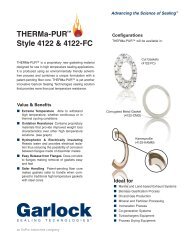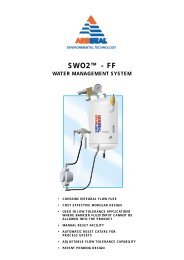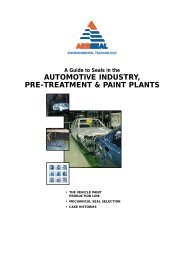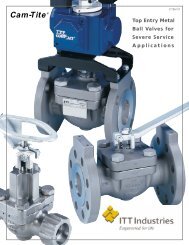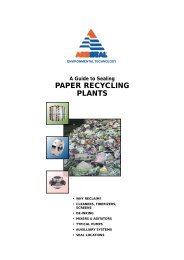expansion joints - AR Thomson Group
expansion joints - AR Thomson Group
expansion joints - AR Thomson Group
You also want an ePaper? Increase the reach of your titles
YUMPU automatically turns print PDFs into web optimized ePapers that Google loves.
Joint Installation (cont’d)<br />
2. Piping Misalignment - Installation of <strong>expansion</strong><br />
<strong>joints</strong> may sometimes be complicated due to misalignment<br />
of the piping system.<br />
The allowable piping misalignments are shown<br />
in Appendix, Table IV. Figure 10 shows a method for<br />
installing standard <strong>expansion</strong> <strong>joints</strong> with minor lateral<br />
and torsional misalignment of the metal flanges.<br />
The methods shown in Figures 9 thru 11 can be<br />
used for lateral and torsional misalignment of 1/4"<br />
for up to 46" I.D. <strong>joints</strong> and 1/4" - 3/8" for larger I.D.<br />
<strong>joints</strong>. Greater lateral and torsional misalignments<br />
will require special <strong>expansion</strong> <strong>joints</strong>. Expansion<br />
<strong>joints</strong> can be built with lateral offset of flanges and<br />
they can be either special drilled or supplied with<br />
one flange undrilled for torsional misalignment prob<br />
lems. Garlock can provide the tooling and drilling<br />
procedures needed to drill elastomeric <strong>expansion</strong><br />
<strong>joints</strong> on-site.<br />
Angular misalignment of metal flanges is shown<br />
in Table V. The angular misalignment is determined<br />
from the smallest and the largest flange opening<br />
dimension FF 1 & FF 2 (Figure 7). Standard expan<br />
sion <strong>joints</strong> can be installed in flanges with minor mis<br />
alignment; refer to Table IV. When ordering standard<br />
<strong>expansion</strong> <strong>joints</strong>, the face-to-face of the <strong>expansion</strong><br />
joint must be specified such that the <strong>expansion</strong> joint<br />
will fit into the smaller dimension FF 1.<br />
Substantial angular misalignment of the metal<br />
flanges will require a special <strong>expansion</strong> joint built as<br />
shown in Figure 7.<br />
3. Bolting Sequence - Garlock <strong>expansion</strong> <strong>joints</strong> are<br />
supplied with segmented retaining rings. Bolting of<br />
the retaining rings and torquing of the bolts in each<br />
ring segment should be in the sequence illustrated in<br />
Figure 11. The objective is to bolt the entire retaining<br />
ring segment evenly and to compress the rubber<br />
flanges as uniformly as possible. The use of flat<br />
steel washers will help obtain an effective seal<br />
where the retaining rings are split.<br />
All bolts should be “snug” tight before they are<br />
torqued. Torquing should then be accomplished in<br />
steps gradually and as evenly as possible.<br />
12<br />
The bolts are not considered torqued and “lock<br />
on” until the edges of the <strong>expansion</strong> joint bulge out<br />
or extrude slightly. In many cases, especially on the<br />
larger sizes (I.D.'s), the flange portion may indent<br />
slightly.<br />
4. Maintaining Seal - Check bolt tightness at least<br />
one week after going on-line and periodically there<br />
after. As any rubberlike material takes a “set" after a<br />
period of compression, the bolts may loosen and<br />
require retorquing. It is particularly important to<br />
check bolts during temperature cycles or during<br />
shut-down times.<br />
Control Unit Installation<br />
Control units should be evenly distributed around the<br />
bolt circle of the <strong>expansion</strong> joint. The triangular plate of<br />
the control unit is bolted to the outside of the steel pipe<br />
flange using bolts equal to 1/8" -1/4" diameter smaller<br />
than the lower holes in the control unit plate.<br />
Insert control rods with washers through the top<br />
hole of the first triangular plate. Place compression<br />
sleeve (if required) over control rod. Insert control rod<br />
through second triangular plate. See Figure 5. Place<br />
washers and hex nuts on end of control unit rod.<br />
The control unit rod setting is equal to the combined<br />
dimensions of the <strong>expansion</strong> joint face-to-face, two pipe<br />
flange thicknesses, two thicknesses of control unit<br />
plates, four washer thicknesses, plus maximum elongation<br />
of the <strong>expansion</strong> joint. See Appendix, Table I.<br />
After control units are fully assembled, the exposed<br />
threads at the end of the control unit rod should be<br />
staked to prevent any loosening of the setting.




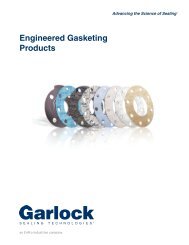
![VCS Flange Gasket [1.03 MB] - AR Thomson Group](https://img.yumpu.com/12044617/1/190x245/vcs-flange-gasket-103-mb-ar-thomson-group.jpg?quality=85)

![PGE Flange Gasket Product Brochure [1.04 MB] - AR Thomson Group](https://img.yumpu.com/12044595/1/190x245/pge-flange-gasket-product-brochure-104-mb-ar-thomson-group.jpg?quality=85)
